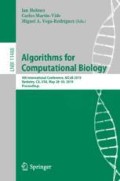Abstract
Dual graphs have been applied to model RNA secondary structures with pseudoknots, or intertwined base pairs. In a previous work, a linear-time algorithm was introduced to partition dual graphs into maximal topological components called blocks and determine whether each block contains a pseudoknot or not. This characterization allowed us to efficiently isolate smaller RNA fragments and classify them as pseudoknotted or pseudoknot-free regions, while keeping these sub-structures intact. In this paper we extend the partitioning algorithm by classifying a pseudoknot as either recursive or non-recursive. A pseudoknot is recursive if it contains independent regions or fragments. Each of these regions can be also identified by the modified algorithm, continuing with our current research in the development of a library of building blocks for RNA design by fragment assembly. Partitioning and classification of RNAs using dual graphs provide a systematic way for study of RNA structure and prediction.
Access this chapter
Tax calculation will be finalised at checkout
Purchases are for personal use only
References
Barends, S., Rudinger-Thirion, J., Florentz, C., Giegé, R., Pleij, C., Kraal, B.: tRNA-Like structure regulates translation of brome mosaic virus RNA. J. Virol. 78(8), 4003–4010 (2004)
Condon, A., Davy, B., Rastegari, B., Zhao, S., Tarrant, F.: Classifying RNA pseudoknotted structures. Theor. Comput. Sci. 320(1), 35–50 (2004)
Dirks, R.-M., Pierce, N.-A.: A partition function algorithm for nucleic acid secondary structure including pseudoknots. J. Comput. Chem. 24(13), 1664–1677 (2003)
Edmonds, J., Karp, R.-M.: Theoretical improvements in algorithmic efficiency for network flow problems. J. ACM 19(2), 248–264 (1972)
Fera, D., et al.: RAG: RNA-As-Graphs web resource. BMC Bioinform. 5, 88 (2004)
Ford, L.R., Fulkerson, D.R.: Maximal flow through a network. Can. J. Math. 8(1956), 399–404 (1956)
Gan, H.-H., Pasquali, S., Schlick, T.: Exploring the repertoire of RNA secondary motifs using graph theory; implications for RNA design. Nucleic Acids Res. 31(11), 2926–2943 (2003)
Gan, H.-H., et al.: RAG: RNA-As-Graphs database-concepts, analysis, and features. Bioinformatics 20(8), 1285–1291 (2004)
Han, B., Dost, B., Bafna, V., Zhang, S.: Structural alignment of pseudoknotted RNA. J. Comput. Biol. 15(5), 489–504 (2008)
Harary, F.: Graph Theory. Addison-Wesley, Boston (1969)
Hopcroft, J., Tarjan, R.: Efficient algorithms for graph manipulation. Communi. ACM 16(6), 372–378 (1973)
Izzo, J.-A., Kim, N., Elmetwaly, S., Schlick, T.: RAG: an update to the RNA-As-Graphs resource. BMC Bioinform. 12, 219 (2011)
Jain, S., Bayrak, C.-S., Petingi, L., Schlick, T.: Dual graph partitioning highlights a small group of pseudoknot-containing RNA submotifs. Genes 9(8), 371 (2018)
Jain, S., Ramos, S.-B., Laederach, A., Schlick, T.: A pipeline for computational design of novel RNA-like topologies. NAR 46(14), 7040–7051 (2018)
Jain, S., Saju, S., Petingi, L., Schlick, T.: An extended dual graph library and partitioning algorithm applicable to pseudoknotted RNA structures. Methods (2019). https://doi.org/10.1016/j.ymeth.2019.03.022. Accessed 1 Apr 2019
Kim, N., Petingi, L., Schlick, T.: Network theory tools for RNA modeling. WSEAS Trans. Math. 12(9), 941–955 (2013)
Kravchenko, A.: Predicting RNA secondary structures including pseudoknots. University of Oxford internal report (2009)
Lai, D., Proctor, J.-R., Zhu, J.-Y., Meyer, I.-M.: R-CHIE: a web server and R package for visualizing RNA secondary structures. Nucleic Acids Res. 40(12), e95 (2012). e-RNA: https://www.e-rna.org/r-chie/rfam.cgi. Accessed 4 Jan 2019
Petingi, L., Schlick, T.: Partitioning RNAs into pseudonotted and pseudoknot-free regions modeled as dual graphs. q-bio.QM, arXiv:1601.04259 (2016). http://arxiv.org/abs/1601.0425. Accessed 4 Oct 2018
Petingi, L., Schlick, T.: Partitioning and classification of RNA secondary structures into pseudonotted and pseudoknot-free regions using a graph-theoretical approach. IAENG Int. J. Comput. Sci. 44(2), 241–246 (2017)
Petingi, L.: Dual graph partitioning code. https://github.com/Louis-Petingi/Partition-Algorithm-3. Accesed 3 Jan 2019
Schlax, P.-J., Xavier, K.-A., Gluick, T.-C., Draper, D.-E.: Translational repression of the Escherichia coli alpha operon mRNA: importance of an mRNA conformational switch and a ternary entrapment complex. J. Biol. Chem. 276(42), 38494–38501 (2001)
Wong, T.-K., Lam, T.-W., Sung, W.-K., Cheung, B.-W., Yiu, S.-M.: Structural alignment of RNA with complex pseudoknot structure. J. Comput. Biol. 18(1), 97–108 (2011)
Acknowledgments
We would like to thank first the referees for improving the content of the paper. NIGMS support from award R35GM122562 to T. S. is gratefully acknowledged. The work of L. P. was supported by PSC-CUNY Award \(\#\) 61249-00-49 of the City University of New York.
Author information
Authors and Affiliations
Corresponding author
Editor information
Editors and Affiliations
Appendix
Appendix
Let (a, b) represents an edge of a dual graph with end-vertices a and b.
We are next illustrating the output of the partitioning algorithm tested on the tRNA-like-structure dual graph (see Fig. 6).

Rights and permissions
Copyright information
© 2019 Springer Nature Switzerland AG
About this paper
Cite this paper
Petingi, L., Schlick, T. (2019). Graph-Theoretic Partitioning of RNAs and Classification of Pseudoknots. In: Holmes, I., Martín-Vide, C., Vega-Rodríguez, M. (eds) Algorithms for Computational Biology. AlCoB 2019. Lecture Notes in Computer Science(), vol 11488. Springer, Cham. https://doi.org/10.1007/978-3-030-18174-1_5
Download citation
DOI: https://doi.org/10.1007/978-3-030-18174-1_5
Published:
Publisher Name: Springer, Cham
Print ISBN: 978-3-030-18173-4
Online ISBN: 978-3-030-18174-1
eBook Packages: Computer ScienceComputer Science (R0)

